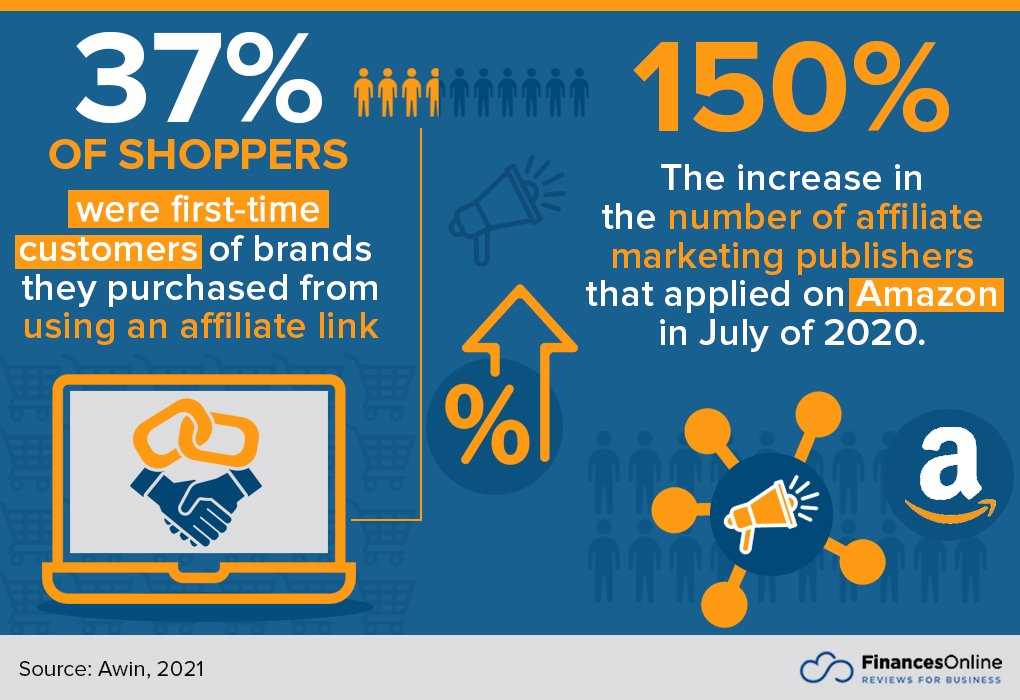Affiliate marketing is taking the United States by storm. Some estimates suggest that affiliate marketing spending will reach in excess of $8.2bn by 2022. That’s an increase of more than $2.5bn from only 2017.
What can you take from this information?
The prevailing opinion seems quite clear. The numbers suggest that merchants think affiliate marketing is a great way to advertise their products. They’re willing to spend big on this strategy.
From a marketing perspective, it appears that there’s a great opportunity to make some serious profits if you’re smart about things. Of course, that’s where the water begins to get a bit murky—where money is involved.
Many people unknowingly spread misconceptions about affiliate marketing, because it’s such an attractive prospect on the face of things. There’s plenty of reason to invest your time and energy into affiliate marketing, yes. But to make a success of things, either as a merchant or a marketer, you need to dispel any myths you’ve come to accept as truths.
Before you start your next affiliate program or brand ambassador search, get up to speed on the myths and misconceptions commonly attached to affiliate marketing.
But first…
What is Affiliate Marketing?
To grasp the misunderstandings attached to affiliate marketing, you need to start with the basics.
Plenty of people have heard something about affiliate marketing before, but often, it’s only a few loose details. Just enough to misconstrue what’s really going on.
Simply put, affiliate marketing is where a marketer promotes the products of a merchant in return for a small commission fee.
With affiliate marketing, you have three parties involved:
- The merchant
- The affiliate marketer
- The consumer
The Affiliate Marketing Process
Essentially, the merchant creates a product before making an agreement with the affiliate marketer to promote that product on their blog or site. Marketers produce content related to the product and place their affiliate links in their work.
When a consumer moves through the order to cash process, purchasing the product having clicked on that link, the affiliate marketer earns a commission. Some affiliate agreements will have commission based on click-throughs, notably.
Now, if you’re wondering how to get affiliates for your product, that’s a straightforward enough query. For merchants and marketers, affiliate agreements are most easily found through affiliate networks.
Affiliate Networks
An affiliate network is an intermediary service between marketers and merchants. Such networks make it easier for merchants and affiliate marketers to find each other.
From a marketer’s perspective, there is usually a wide array of affiliate programs to choose from that are relevant to their niche. For merchants, there are countless numbers of marketers and publishers that might be interested in promoting your product.
Generally speaking, a merchant creates an affiliate program for interested marketers. This program lays out the various terms and commission agreements related to product promotion.
The conditions of the program will often vary from one product type to the next. It makes sense that an affiliate program that seeks out software tester expertise might vary from one where children review toys, for example.
With this information, you have a basic understanding of affiliate marketing. But what about some of the misinformation you might have come across before now? It’s time to bust those myths.
Debunking 5 Damaging Myths And Misconceptions
There’s a raft of marketers and merchants out there, rubbing their hands at the prospect of using affiliate programs to make some serious money.
Yes, there’s a fabulous opportunity for a mutually beneficial relationship here. Even so, there are numerous misconceptions that you’d do well to forget about. Here are the five worst myths that need to be debunked.
1. The Market is Already Too Saturated
This is a concern that we hear all the time. It’s true that affiliate marketing has exploded in popularity over the last few years.
This means that the broader markets that you might operate in are going to be very competitive. However, that doesn’t mean that there aren’t valid opportunities for you to carve out a space for yourself.
Typically, affiliate marketers who are struggling to make headway are taking the wrong approach. They’re trying to grab the attention of too broad an audience. The most effective way to get attention is through aggressively targeting a niche within a wider market.
Find a topic that fits with your expertise—hopefully, something that interests you—and go with it. Market gaps exist, you simply have to find angles that other marketers haven’t thought of already.
Remember to examine the associated keywords for your niche to find out what might be most profitable.
2. High Volume Website Traffic is All That Matters
For an affiliate website, the number of visitors received is important. That’s a truth that rings true for all affiliate sites. Yet, the volume of website traffic you receive isn’t the only factor in the success of your approach.
Far more important than the number of visitors is the quality of visitors. It’s always important to remember that a higher volume of traffic doesn’t always translate to more sales.
The effectiveness of certain affiliate marketing traffic sources is ultimately down to how well they convert. If you’re getting a good amount of traffic, but you’re not getting click-throughs leading to sales, it’s time to re-evaluate things.
You can assess the quality of the traffic that your website is receiving to determine where you might be struggling.
Learning about the keywords that you’re integrating into content—and the type of traffic they produce—can be particularly enlightening. Analyzing your site’s technical performance—think about load times, bugs, display issues, and so on—is another critical task.
Optimizing your site’s content and design to receive the right traffic is what actually matters.
3. Achieving Affiliate Marketing Success is Quick and Easy
If your position is that affiliate marketing is easy, quick, and allows you to make profits effortlessly, you’re not the only one.
But the sad fact is that this is far from the truth.
Many people agree that to reach the top of the relevant search results, you’re going to need months, and sometimes more than a year. That hardly sounds like a get-rich-quick opportunity, does it?
The most effective affiliate sites offer value for consumers through content. That isn’t possible without focus and dedication. Finding fresh content ideas that will matter to your audience requires insightful research. Something that isn’t achievable on a whim. Showing your expertise over time, through consistent content production, is your best bet.
You might also need to explore innovative strategies to set yourself apart. Some affiliate sites are using .ai domain names (Anguilla-based domains) due to artificial intelligence associations with the abbreviation. For certain software products, this can act as a decent hook to grab visitors’ attention.
The time-tested approach pays dividends in the long run, certainly, but it’s not quick and it’s not easy.
4. Consumers Are Reluctant to Buy Through Affiliates
This is a total myth, and one that scares many people away from affiliate marketing altogether.
It’s true that many consumers do not like to be sold to. Hard selling causes discomfort for many consumers and could turn them away from a product that they would otherwise have bought.
The perception that many consumers have is that, if you’re trying to sell forcefully, desperately even, then it’s all about the money. It’s not about making a good recommendation. Needless to say, this is a major turn-off for people who are seeking guidance.
Consumers need to be able to trust your expertise. If you make an earnest attempt to recommend products and services which fill a need and perform well, consumers will respond in kind.
You should always be clear about the possibility that you’ll earn a small commission, too. Dishonesty is the most effective way to undermine your affiliate business in the long run. Otherwise, however, you shouldn’t have any issues.
5. Affiliate Marketing Gets You Rich Through Passive Income
This is the primary reason that people become interested in affiliate marketing as a money-making scheme. They’ve heard about websites sprouting up and delivering passive income to the tune of hundreds of thousands of dollars.
Making a fortune without having to lift a finger, sounds pretty good, doesn’t it? Unfortunately, it is too good to be true.
You often see people asking “how much do affiliate marketers make?”–and it’s a fair query. Nobody is suggesting that there isn’t an excellent opportunity to make money through affiliate programs. In fact, some affiliate businesses manage to make millions. But many affiliate marketers do not make that much, and truly passive income is rarely possible.
Only once you manage to establish real authority in your niche will the pressure begin to dissipate. At that point, you can begin to take your foot off the pedal, but the income is never going to be entirely passive.
Retaining a loyal user base that values your opinion requires you to keep creating value-packed content. If you behave too passively, you risk the success of your business.

Quashed: The Most Harmful Affiliate Marketing Myths
It’s tempting to think of affiliate marketing as a way to get rich without much effort. It’s equally tempting to throw in the towel because you feel markets are stuffed full of competitors.
Yet, both of these instincts are harmful to your future prospects. There’s a good probability that you can attain a fine income with affiliate marketing, as long as you bear in mind that:
- Income is not truly passive, it requires work.
- Website traffic quality matters more than quantity.
- Commission transparency is essential.
With these insights, success awaits you.
Author Bio:

Sam O’Brien is the Chief Marketing Officer for Affise—a Global SaaS Partner Marketing Solution and industry leader for AI affiliate marketing. He is a growth marketing expert with a product management and design background. Sam has a passion for innovation, growth, and marketing technology. Here is his LinkedIn.




















































 |
|